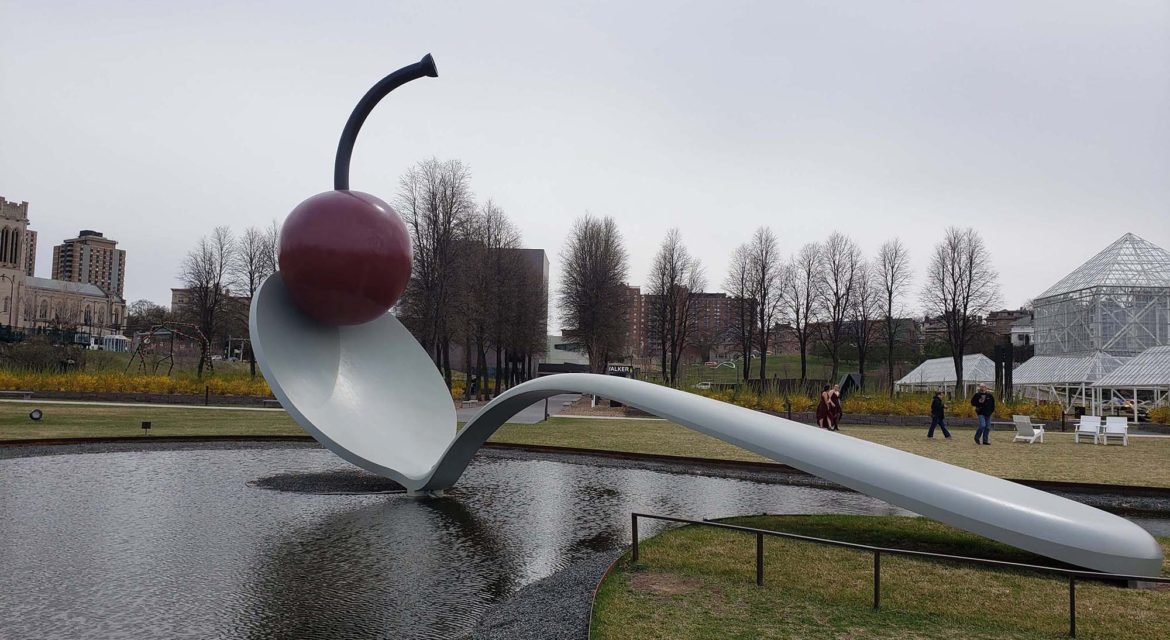 Sculptures such as the Little Mermaid in Copenhagen and Manneken Pis in Brussels have become icons of their respective cities, and the same thing has happened for Minneapolis, Minnesota with “Spoonbridge and Cherry”. This whimsical, 50-foot long piece has delighted visitors ever since it was installed and is now a familiar and iconic symbol for the Twin Cities.
Sculptures such as the Little Mermaid in Copenhagen and Manneken Pis in Brussels have become icons of their respective cities, and the same thing has happened for Minneapolis, Minnesota with “Spoonbridge and Cherry”. This whimsical, 50-foot long piece has delighted visitors ever since it was installed and is now a familiar and iconic symbol for the Twin Cities.

A Piece of Functional Art
The Minneapolis Sculpture Garden is an 11-acre park located near the Walker Art Center. One of the largest urban sculpture gardens in the country, it resides in the heart of Minneapolis and features over 40 permanent installations of modern and contemporary art.
 “Spoonbridge and Cherry” was the first work commissioned for the Minneapolis Sculpture Garden, which opened in 1988. The Center commissioned artist Claes Oldenburg and his wife, Coosje van Bruggen to create a piece that needed to serve as both a piece of art and a fountain. Oldenburg was an artist who was known for making oversized versions of everyday objects and food products. The spoon was Oldenburg’s idea while the cherry was Bruggen’s, as she felt the cherry “energized the subject.” The cherry’s stem acts as a fountain which sprays into the bowl of the spoon and off into the pond beneath.
“Spoonbridge and Cherry” was the first work commissioned for the Minneapolis Sculpture Garden, which opened in 1988. The Center commissioned artist Claes Oldenburg and his wife, Coosje van Bruggen to create a piece that needed to serve as both a piece of art and a fountain. Oldenburg was an artist who was known for making oversized versions of everyday objects and food products. The spoon was Oldenburg’s idea while the cherry was Bruggen’s, as she felt the cherry “energized the subject.” The cherry’s stem acts as a fountain which sprays into the bowl of the spoon and off into the pond beneath.
The shape and placement of the piece totally transformed the space, as the cherry itself attracts viewers from afar while also drawing attention to the shape of the pond. Additionally, the piece takes on a new aspect in the winter season, evoking similarities to an ice cream sundae.
Open 365 days a year, from 6 am to 12 midnight, the Minneapolis Sculpture Garden allows visitors to engage with “Spoonbridge and Cherry” in numerous ways, but that engagement is just part of the reason it has become an icon for the city.

The Economic and Cultural Impact of an Icon
Shops and stores across Minneapolis feature and sell items that incorporate “Spoonbridge and Cherry” in a variety of ways. Whether it’s practical items designed to appeal to residents or souvenirs that are more for tourists, the piece has made a direct economic impact across the city by providing many different storefronts with the opportunity to sell merchandise associated with the piece.
Additionally, “Spoonbridge and Cherry” is featured in countless maps and tour guides that highlight the various things to do and see in Minneapolis. Everything from the “Official Guide to the Twin Cities Area” to “Meet Minneapolis” feature the sculpture to directly and indirectly compel visitors to make a trip to see the piece. “Spoonbridge and Cherry” has been able to serve an especially unique attraction for such materials.
 While the piece has become a genuine tourist attraction, it’s the embrace of the piece by the community that has been even more important. As an illustration of what that can mean, wedding photos and other event photographs take place on a regular basis at the Sculpture Garden, with “Spoonbridge and Cherry” being an important element of these photos. Additionally, universal outrage was expressed when the piece was vandalized in 2012 as part of a “Kony 2012” protest, illustrating what kind of significance the piece has come to represent for the wider community.
While the piece has become a genuine tourist attraction, it’s the embrace of the piece by the community that has been even more important. As an illustration of what that can mean, wedding photos and other event photographs take place on a regular basis at the Sculpture Garden, with “Spoonbridge and Cherry” being an important element of these photos. Additionally, universal outrage was expressed when the piece was vandalized in 2012 as part of a “Kony 2012” protest, illustrating what kind of significance the piece has come to represent for the wider community.
These examples illustrate what kind of literal impact “Spoonbridge and Cherry” has had on the culture and economy of the city, but that’s just part of the legacy it represents for the city as a whole.

An Undeniable Part of Minnesota
“Spoonbridge and Cherry” has been described as “an undeniable part of the city,” and that reality can be seen in the Minneapolis Sculpture Garden as well as in the shops, stores, pictures and brochures across the city. By creating an icon that appeals to both residents and tourists in different ways, “Spoonbridge and Cherry” has become a vital aspect of the present and future of the Twin Cities.

